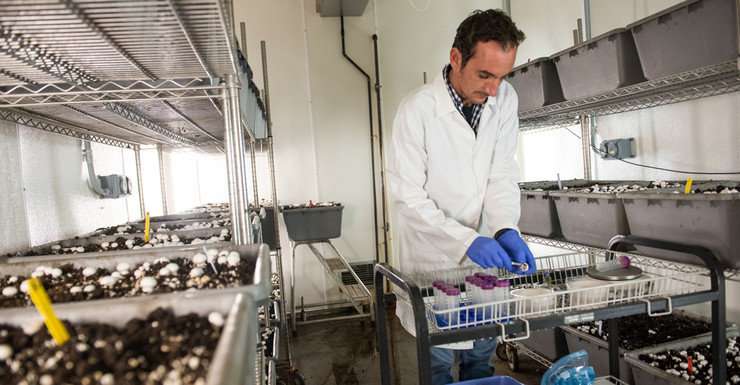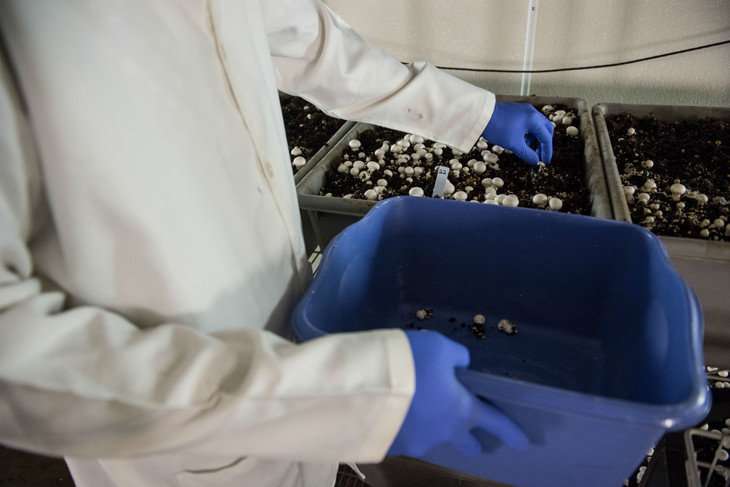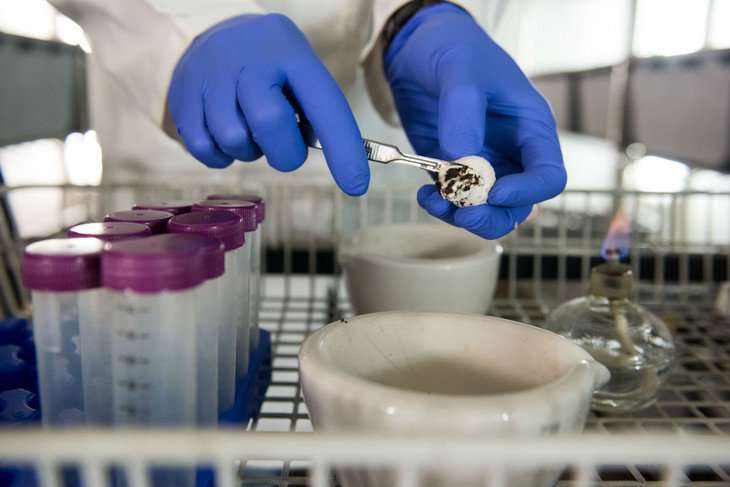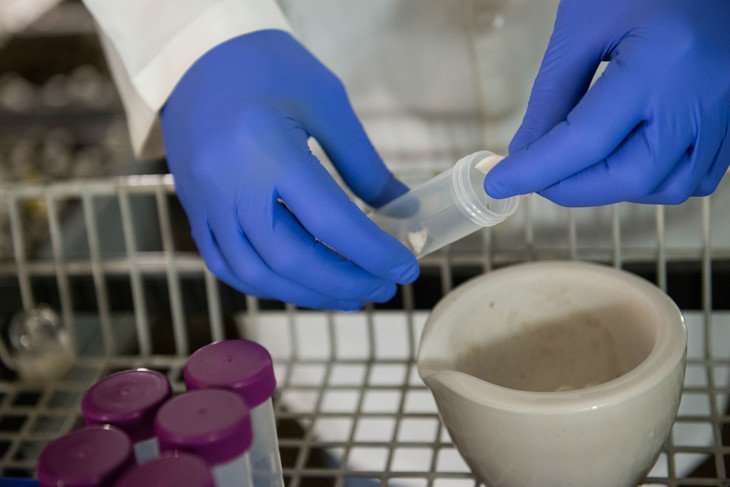New high-throughput sequencing technologies uncover a world of interacting microorganisms

Your body teems with them—100 trillion microbes in your gut, lungs, mouth, and skin. Your home swarms with them—in toilets and sinks, on tables and chairs, in the carpet, and on your dog. Even the ground on which you stand abounds with countless bacteria, fungi, protozoa, algae, and viruses—all microscopic, all part of a community of organisms interacting with one another and the environment. These communities and the environments with which they interact are known as "microbiomes," and our growing understanding of them is changing the way we treat diseases, grow crops, and create everyday products.
It's changing how we view nature.
Scientists at Penn State and in the College of Agricultural Sciences are at the forefront of research on microbiomes. They are probing human and animal guts to learn how microorganisms influence health, and they are exploring the soils to uncover how microbes benefit crops. Through this work the scientists are gaining an appreciation for the complexity of microbial life on Earth. And they're also exploring the potential benefits and challenges these creatures present.
The human journey into the realm of the microscopic began in 1657, when Antoni van Leeuwenhoek, a draper living in Delft, Holland, revealed that he had discovered, by looking through his self-created simple microscope, tiny "animalcules" living in lake water.
In a letter to the newly formed Royal Society of London, van Leeuwenhoek wrote that these animalcules were "so small, in my sight, that I judged that even if 100 of these very wee animals lay stretched out one against another, they could not reach the length of a grain of coarse sand.. . 'twas wonderful to see."
Van Leeuwenhoek's discovery of microorganisms constituted an unprecedented shift in human understanding of the natural world. All of a sudden, life on Earth became at once considerably more complex and exceedingly marvelous. And yet, more than 350 years later, we remain in the dark about who many of these creatures are and what they are doing.
"Depending on who you talk to, we may not know anything about 99 percent of the microorganisms in the environment," says Carolee Bull, professor and head of the Department of Plant Pathology and Environmental Microbiology. But, she adds, much like the shift that occurred after van Leeuwenhoek discovered microbes, a modern-day scientific revolution promises to reveal the identities and activities of the communities of microorganisms that so greatly impact our lives.
This time, the tool making it all possible is high-throughput sequencing—also known as next-generation sequencing. First available in the year 2000 and only widely used since the last decade, the technology can determine the order of nucleotides—the As, Ts, Gs, and Cs—for hundreds of thousands of DNA molecules from myriad species concurrently. The technology makes it possible to learn the identities of every species present in a small sample of, for example, pond water. Simple DNA sequencing, on the other hand, is much more limited in its abilities.

"The concept of microbiomes isn't particularly new," says Bull. "But with high-throughput sequencing, the black box of microbiology is finally being illuminated," says Bull. "It's showing us that microbes don't work alone in a vacuum. Instead, they are part of a community in which the environment, other organisms, and microbes influence and respond to each other."
Protecting Water Quality and Restoring Soils
Soil microbiome is a complicated study subject. A teaspoon of soil likely contains a billion individual bacterial cells, perhaps 500,000 fungal fragments, thousands of protozoa, and who knows how many viruses, says Mary Ann Bruns, associate professor of ecosystem science and management. And of the bacteria alone, she adds, there may exist 10,000 to 20,000 different species.
Bruns is using high-throughput sequencing, among other tools, to tease apart this "DNA soup," as she calls it, that is contained within soil. Her research on nitrogen-cycling microbes at the field scale fits into the bigger picture of reducing nutrient transport to coastal dead zones. "Overall, half of the nitrogen in fertilizer that's applied to crops is not taken up by the crops," she says. "Instead it leaches to the groundwater or runs off in sediment. Much of that nitrogen eventually makes its way into the Gulf of Mexico and the Chesapeake Bay, where it upsets ecosystems. I'm interested in how we can stop this process at the source, how we can make our nitrogen application and management methods less wasteful."
The key, she says, lies in finding nitrogen-conserving plant-soil microbial communities because they are responsible for much of the nutrient cycling in the soil. For example, microbes convert ammonium to nitrate, which is the most easily lost form of nitrogen. "Certain microbes are responsible for many of the biochemical reactions in soil that result in poor efficiency," says Bruns. "In traditional agriculture, we have countered this problem of nitrogen loss by adding an insurance amount. It's cheaper and easier to add more rather than try to figure out how to prevent losses in the first place."
The good news is that while some microbes promote the loss of nitrogen from soil, other species are capable of fixing nitrogen from the atmosphere and keeping it in place. Using high-throughput sequencing, Bruns and one of her graduate students characterized a mixture of two closely related strains of cyanobacteria and several species of nonphotosynthetic bacteria that form biofilms quickly on soils to reduce erosion and runoff. This "consortium," she says, could be added to agricultural soil to fix carbon and nitrogen and help nutrients stay in place, thus reducing the need for additional applications of nitrogen and protecting downstream environments from nitrogen pollution.
Bruns says she would like to see companies take an interest in such products and develop them for agricultural use. For example, such microbial products could be applied, along with amendments, to reclaim damaged land, another area where microbiome research provides insights. Bruns and postdoctoral associate Claudia Rojas used next-generation sequencing to show increases in beneficial mycorrhizal fungi and rhizobia in revegetated mine land after adding moderate amounts of compost and lime.
Terrence Bell, assistant professor of plant pathology and environmental microbiology, is also interested in creating microbial consortia that can be added to soils to improve their function. He's focused on restoring soils that have lost their microbial activity due to overuse of fertilizers and chemicals. "Some agricultural soils are depleted of the essential microorganisms needed for crop growth because they have been treated with chemical fertilizers for so long," he says.

Through experimental studies, Bell and one of his undergraduate students have shown this to be the case. They applied different types of nutrient amendments to soils and found that soils exposed to high amounts of chemical phosphorus experienced shifts in the composition of the microbiome, including a reduction in microbial diversity, which appeared to impact the growth of crops.
"Our next step is to figure out if we can counteract this problem by reintroducing microbial diversity to these environments," says Bell.
As with Bruns's research, the task requires use of the latest sequencing techniques. "It really comes down to the tools available, and the fact that it's still only been less than a decade since high-throughput sequencing has been widely used in our field," says Bell. With these technologies, "we're zeroing in on functions," adds Bruns. "Most organisms are not pathogenic or disease causing, they are just there waiting for the right conditions to become active. Our goal is to understand it and to use the knowledge to our benefit."
Gut Check
The environment of the human gut comprises tens of trillions of individual microorganisms, collectively weighing nearly 4.5 pounds. Many of these microbes are implicated in reducing the risk of cancer, depression, obesity, and even autism. In fact, "good" bacteria are becoming so popular for their positive health effects that the newly emerging probiotic industry netted more than $35 billion in profits in 2015. But some species are linked to problems.
Consider obesity. In the United States alone, 34 percent of adults and 15 to 20 percent of children and adolescents are obese. In recent years, researchers and clinicians have been turning to the gut microbiome to try to better understand this problem. Fecal matter is 50 percent bacteria. Microorganisms must be playing an important metabolic role.
Andrew Patterson, associate professor of veterinary and biomedical sciences, has learned a great deal about how bacteria influence obesity and the metabolic diseases associated with obesity, namely type II diabetes and non-alcoholic fatty liver disease. For instance, in his studies, he has noticed that mice given tempol, a drug typically used to protect cells against radiation damage, weigh significantly less than mice not given the drug. To investigate further, he and his team designed an experiment in which they fed mice a high-fat diet and gave them the drug tempol. They found that these mice gained significantly less weight than mice that were fed a high-fat diet but were not given tempol.
Patterson determined that the tempol was likely reducing the amounts of Lactobacillus and Clostridium bacteria in the mice guts. And when these bacteria decreased, a specific bile acid—known as tauro-beta muricholic acid—increased. "For some reason the bacteria metabolize bile acids either as a protective mechanism, or as a way of scavenging off nutrients for growth," he says.

Secreted from the liver into the intestine, bile acids are responsible for digesting dietary fats and oils. "If you have a disorder in these types of processes then you have a really hard time digesting fat," says Patterson.
To determine what was going on between the Lactobacillus and bile acids, Patterson turned to metabolomics—the study of the chemical fingerprints that are left behind after cellular processes take place. He learned that when the bile acid tauro-beta muricholic acid increases, it turns off the farnesoid X receptor (FXR), which is responsible for regulating the metabolism of bile acids, fats, and glucose in the body. "FXR is there to say, 'Hey, there's enough bile acid in the intestine, shut off synthesis in the liver, or there's not enough bile acid so synthesis needs to be turned on,'" says Patterson.
The revelation about FXR's involvement led Patterson and his colleagues at the Hershey Medical Center and the National Cancer Institute to design their own anti-obesity drug that specifically targets FXR. In less than two years, they created a pill, modeled after tauro-beta muricholic acid but made from glycine-beta muricholic acid, that caused mice to gain significantly less weight and have less insulin resistance when fed a high-fat diet than mice in the untreated control group.
Patterson received a RAIN grant from the college to help commercialize his product. He also formed a company, called Heliome Biotech, Inc., to commercialize the drug, along with any others that may arise. But Patterson cautions that although his drug has the potential to help patients, it isn't a cure-all. "I don't think this is going to be the magic pill that allows you to eat a tub of ice cream every day and not see any metabolic problems later in life," he says. "You have to adopt a healthy lifestyle as well."
Lactobacillusisn't the only bacteria with strains that can cause problems.E. coli, too, which is common and generally benign throughout the human gut, includes at least one very dangerous strain—O157:H7. This bacterium enters the body through contaminated foods.
"One of the things that makes O157:H7 so terrible is when it gets in your intestines it produces a powerful toxin called Shiga toxin that is responsible for a lot of the serious symptoms of disease, from mild diarrhea to severe kidney damage," says Edward Dudley, associate professor of food science. "The question is what's the difference between the people who only get diarrhea and those who get terribly sick?"
Dudley believes our gut microbiomes might hold the key to this question. "Could it be that different microorganisms in our gut—what I carry versus what you carry—could cause our reactions to O157:H7 to be different? After all, when O157:H7 enters our intestines, it's not existing there by itself; it's interacting with hundreds of microorganisms that are found in our gut. We are asking whether any of these organisms that O157:H7 finds itself setting up shop with do anything that may either increase or decrease the amount of toxin that the organism produces."
Those suspicions were confirmed when Chun Chen, a former Ph.D. student of Dudley's, grew O157:H7 in the laboratory together with a variety of strains of common gut E. coli. "When grown together with O157:H7 some of them dramatically increase the amount of toxin that O157:H7 produces, suggesting what E. coli strains are in your intestines might actually play a role in dictating the course of the disease," says Dudley.

Another one of Dudley's former students, Kakolie Goswami, along with a colleague from the University of Michigan, repeated the experiment using sterile mice that contained no bacteria. They inoculated those mice with O157:H7 and also with a nonpathogenic strain of E. coli that he'd previously shown in the laboratory to amplify Shiga toxin. They found the same result: the mice with the O157:H7 and the other strain of E. coli did worse than the mice with only O157:H7.
According to Dudley, antibiotics can't be used to treat O157:H7 the way they can with other bacteria. In fact, antibiotics actually increase the amount of Shiga toxin that the pathogen produces. As a result, doctors simply monitor patients and treat their symptoms. "By knowing which E. coli strains a patient carries, doctors could predict the course of the disease in patients and be prepared with various treatments," says Dudley. He adds that it also may be possible to use certain strains of E. coli as a probiotic that patients could ingest that would block the ability of O157:H7 to produce large quantities of toxin.
"For decades, we studied various bacteria growing as pure cultures in the lab, when in reality, whether it's human health or in the soils or oceans, no bacteria, except a very tiny number of them, exist by themselves," says Dudley. "They are always in a community of other organisms. Now we're really beginning to pick apart just how an organism of interest behaves differently when it's in the presence of other organisms. There is much to learn."
Indeed, microbiome research is an open book with the potential to transform our lives. "We know now that microbiomes are driving more than we ever thought," says Bull. "There is a wealth of information that we have only just begun to tap."
Bull notes that it's important for public institutions, like Penn State, to be involved in this type of research. "As a land-grant institution, Penn State is mandated to create knowledge for the greater good," she says. "For example, if you talk to a farmer, he or she will tell you, 'This is my best soil; anything I grow here will be fine,' but a hundred yards away, he or she might say, 'This is not a great spot,'" says Bull. "Farmers know the difference because they've seen the yields, but they do not know why one spot is great for their crops and the other is not. It's our job as scientists to do the research and give them the answer for that."
Provided by Pennsylvania State University




















